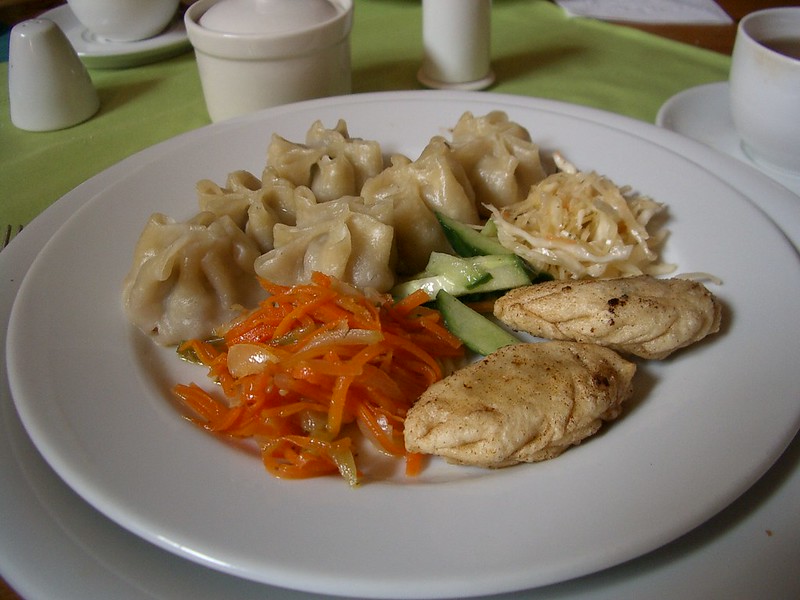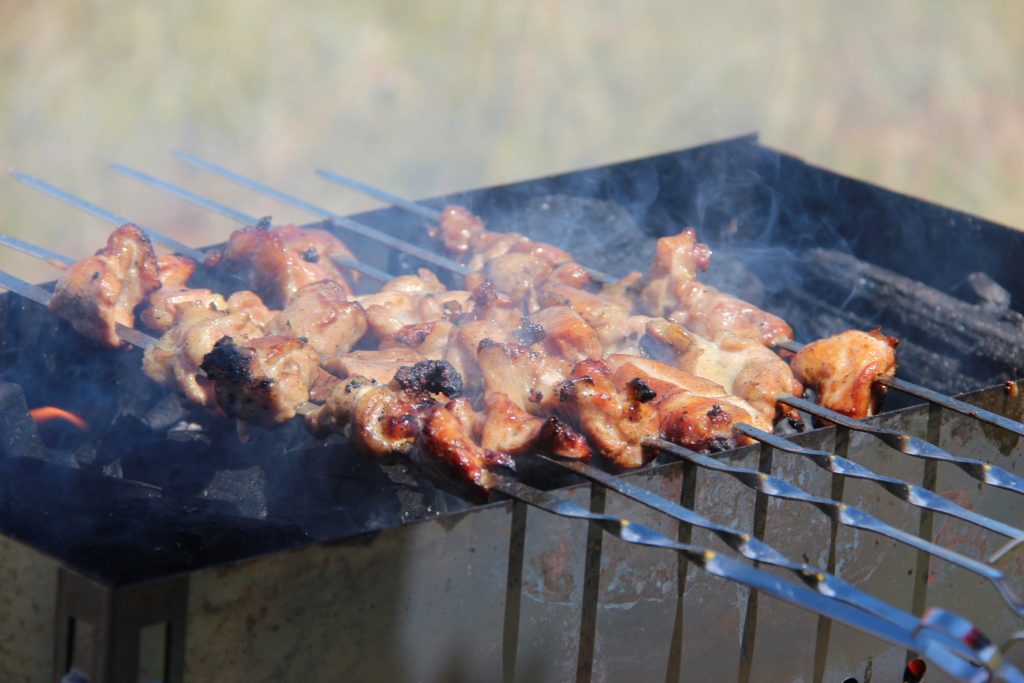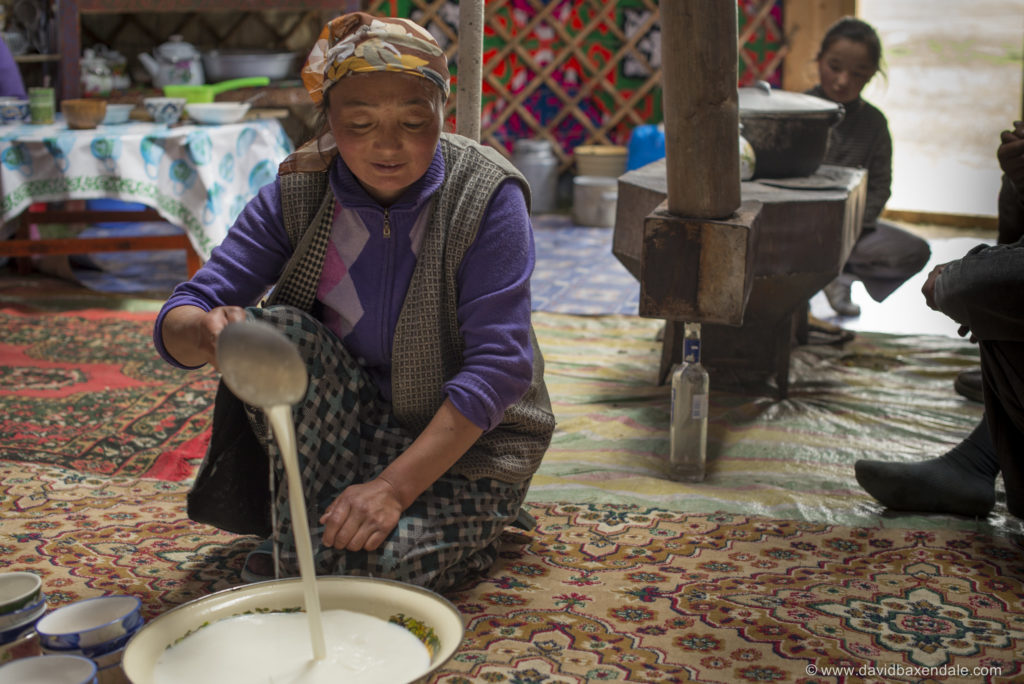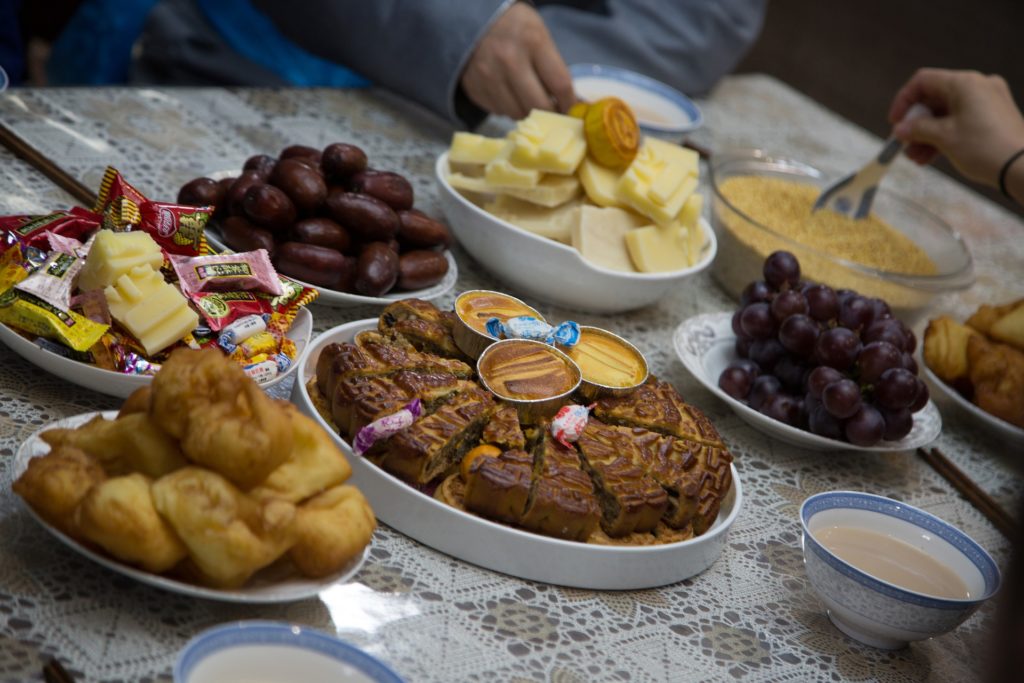When it comes to Mongolian food, we have a mix of traditional types of food and more modern-day foods that were introduced by the USSR and the West.
If you visit Ulaanbaatar for instance, you will find all kinds of restaurants that such as Korean, Chinese, European, and Mongolian. It would be wrong to assume that food variety in Mongolia is lacking, but it is, however, true that just a few decades ago, food choices and variety weren’t as common compared to today in the 21st century.
Traditional foods on the other hand have been a part of Mongolian culture for a very long time and are usually very simple and easy to make. However, even if it looks simple on the surface, it actually does require a lot of soul and mindfulness in the preparation phase.
Mongolian Food Culture
The food culture in Mongolia is about sharing with other people, hence most traditional foods are non-portion-based, but rather a whole chunk that gets divided among the people.
Hence there are no recipes or specific ingredients for certain types of dishes because the process of making food is about the soul and feeling the food in one sense. Because it is your own creation and even if you have the exact same ingredients, the foods can end up tasting very differently depending on who cooked it. Asking someone the recipe/the mechanics and the exact details of the food will be unfruitful because they will just answer in generalities.
During festivals and national celebrations, you will have many guests around a big table sharing a big meal. Each individual gets their own plate and helps themselves; it’s somewhat similar to Thanksgiving in America with different types of food.
Another thing to note about Mongolian cultural foods is the heavy meats. Mongolians love to eat all kinds of meats, from a horse, mutton, cow, goat, and more recently pork due to Western influence. However, dogs are a different story.
Do Mongolians Eat Dogs?
The short answer is no, Mongolians do not eat dogs, but being an Asian country and bordering China, it occasionally does come about from foreigners wondering if Mongolian people sometimes eat dogs.
Dogs are seen as loyal guards and having been heavily influenced by Buddhist influence from Tibet, dogs are not seen as a food source. It will be considered rude to even ask the question from a Mongolian.
What Kinds of Foods do Mongolians Usually Eat?
Mongolians usually eat very protein-rich foods with a lot of meat and dairy. Even though Mongolian people have access to vegetables, fish, chicken, and fruits, it is a cultural norm to have a very protein-rich diet.
But it would be wrong to assume Mongolians today only eat very basics foods of the steppe because due to Western influence, many Mongolians nowadays also eat a lot of the foods that you would usually eat as well for breakfast, lunch, and dinner.
Popular Mongolian Dishes & Cuisines
However, let’s get into the main topic. Here is a list of all the dishes and cuisines Mongolian people have grown accustomed to.
Common Household Dishes
Bantan
Bantan is one of the simplest dishes you can make. All you have to do is get some flour and some meat with some salt. You make small crumbs with the flour by mixing them with water. You then mix the flour crumbs and meat in boiling water with some salt and keep stirring. After a while, you will get something similar to chowder and you will have made Bantan.
Tsuivan
If you are making Tsuivan from scratch, preparing the ingredients can take quite a bit of time because the noodles need to be made from scratch by preparing the dough and then cutting it. However, a lot of supermarkets will sell cut noodles, so buying pre-cut noodles are a lot easier.
You can include the meat of your choice, but usually eat is either mutton or cow, mixed in with potatoes, carrots, sometimes onions, and garlic.
Once you have all the ingredients, you put all the ingredients in a big metal bowl with some water and let the water steam the noodles for around 30 minutes.
You can then later use ketchup or soy sauce to give it some flavor. If you have leftovers, you can mix them with hot water or tea. It actually tastes delicious!
Budaatai Khuurga / Plov
Budaatai khuurga could also be called “Plov” because it has been inspired by Central Asians and Russians. However, Mongolian Plov is a little different because there isn’t that much oil, and potatoes are included, whereas non-Mongolian Plovs have dried grapes or include dry meat with some oil.
Budaatai khuurga is a household dish that does not have much significance. Mongolians make the dish whenever they feel like it and eat it whenever they want to. In fact, it is not really prepared during any national celebrations and holidays.
Banshtai Tsai
Banshtai tsai is like a mix between Mongolian milk tea and mini dumplings. Some people put rice, oils, and meats in the mix. You boil suutei tsai and proceed to put in the ingredients and after 20 or so minutes you will have Banshtai tsai.
Lapsha/Guriltai Shul
Lapsha or Guriltai shul is also very simple and is often one of the dishes that Mongolians like to make. You can either get noodles from the store or prepare your own noodles with flour, then you mix meat assortments, potatoes, carrots, onions, garlic, etc in a pot of boiling water and let it simmer.
It is a very simple dish but tastes delicious. Lapsha is perfect for rainy or sick days where you just need some energy or want to get warm.
Khar Shul
Khar shul is heavy meats boiled in water with some garlic. That is it. There is nothing fancy about this soup nor is it intended to be fancy. You make khar shul for sick people who need a boost in energy.
Traditional Dishes For Holidays & Celebrations
Buuz
Buuz is a food that is originated in the Chinese. Most people would know them by the word, dumplings, but in Mongolian, it is called Buuz.
In order to make Buuz, the dough is prepared, and either cow or mutton meat mixed with the same onions are stuffed as fillers. Once you have that ready, you place the buuz inside a steamer and let it sit for 20 or so minutes.
You will most likely see people a lot of buuz during the new year’s and also Lunar New Year.
Some people really like to eat buuz with a lot of meat fat stuffing whereas some people prefer to eat leaner meats, so different households will have different tasting buuz with their preference.
Khuushuur

Khuushuur is very similar to buuz, but unlike buuz, Khuushuur is not steamed but fried and is actually a lot bigger. However, the ingredients that are used are still the same.
If you ever come during the Naadam Festival, then you will experience different variations of Khuushuur, from round circle shapes to foot-sized ones, some Mongolians can get really creative.
Potato Salad
Potato Salad is most commonly served with either Buuz or Uuts and during cultural holidays. The ingredients include mayonnaise, potatoes, onions, pickled cucumbers, pork, and some other additional ingredients depending on the household.
Like the Buuz, every family has their preference and the taste can vary based on who makes it.
Sheep’s Back/Uuts
Since preparing the Uuts takes a lot of time, this is only prepared during big celebrations and during cultural holidays. It takes a lot of hours of boiling the Uuts, and once it is done, it is presented at the dinner table where people are free to cut a piece and help themselves.
However, the first few rounds are cut by the dinner host or an elder person with the most respect and authority. It tastes quite bland, but when it is mixed with other foods it actually starts tasting better.
Get Together Mongolian Cuisines
These dishes and cuisines are not really prepared at home but rather with friends and family when you get together or go on an outing. These foods are mostly reserved for special occasions.
Boodog
Though it is illegal to hunt marmots in Mongolia, Mongolians still make Boodog from marmot meat. You stuff the marmot with hot stones and put vegetables and let the hot stones cook the meat. It is very oily and hardy food, so for first-timers, it will most likely be too much.
Khorkhog
Khorkhog is similar to Boodog, but instead of hunting for marmots which is illegal, you can use the meat of your choice. Usually, people have mutton or goat meat as the main ingredients.

Once the meat is prepared, you have potatoes, onions, and other vegetables in the mix. You then proceed to find stones that are smooth and comfortable to hold in your hand.
You then proceed to heat the stones on coals or a fireplace. All your vegetables and meat should be inside a makeshift pressure cooker / Mongolian pressure cooker. Once the stones are hot enough, you put the stones inside the pressure cooker where the steam and the heat of the stones cook the meat.
Meat Assortments
If you have guests coming over to your house, it is pretty common to have different types of meat assortments. Basically, you boil the big chunk of meat in a pot, flavor it a little, and present it on the table.
As I said, Mongolians love meat, so even it’s very basic and simple, it is still considered good food.
Sheep Head
If you are squirmish then this is not for you, because Mongolians don’t have a problem eating a sheep’s head. The head is first torched to get rid of any skin and fur, then it is later boiled for a long time. Many Central Asian countries have a similar way of preparing the sheep’s head as well.
What do Mongolian People like To Drink?
If we are talking about usual and most common drinks besides modern-day ones, here are a few.
Vodka
It is not a party without some vodka at a celebration. It is considered disrespectful to the dinner host if you don’t at least taste the vodka drink.
Airag

Airag is fermented mare’s milk and tastes quite a bit sour and bitter. It does have some alcohol content so if you drink a lot you can get drunk. Most foreigners are not used to the taste, because it does take some time to start liking them.
Usual Snacks & Desserts Mongolians Eat
Though there are chips, candies, and other snacks of the modern-day luxuries, these are traditional snacks and foods Mongolians like to eat.
Aaruul
Aaruul is dried curd. It is sort of like the Mongolian version of jawbreakers because some of the dried curds can be really hard and tough. It is a good jaw muscle exercise to eat aaruul. Depending on how they are prepared, you can have sweet-tasting ones to very bitter and sour. It is based on people’s preferences.
Boortsog / Mongolian biscuits

Boortsog AKA Mongolian biscuits are deep-fried cookies. In the morning, it is common for people to eat boortsog and if you ever visit the stores in Mongolia, there is a whole aisle and section where you will find different flavors, shapes, and sizes of boortsog.
Ul Boov
Ul Bov, unlike boortsog, is eaten during the holidays. However, most people use it for ceremonial purposes for preparing the dinner table. You won’t see any Mongolian pulling out Ul Bov from the dinner table and start eating it.
The Ul Bov are stacked on top of each other and at the top, you have small aaruul, candy, meat, etc.
Gambir
Gambir is pretty much a Mongolian version of pancakes. They are not sweet, however, but rather salty and sometimes a bit crunchy. It is somewhat similar to an omelet as well, but the main ingredient is flour rather than eggs.
